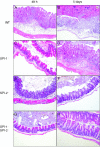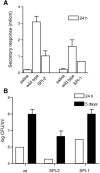Analysis of the contribution of Salmonella pathogenicity islands 1 and 2 to enteric disease progression using a novel bovine ileal loop model and a murine model of infectious enterocolitis
- PMID: 16239510
- PMCID: PMC1273848
- DOI: 10.1128/IAI.73.11.7161-7169.2005
Analysis of the contribution of Salmonella pathogenicity islands 1 and 2 to enteric disease progression using a novel bovine ileal loop model and a murine model of infectious enterocolitis
Abstract
We have developed a novel ileal loop model for use in calves to analyze the contribution of Salmonella enterica serovar Typhimurium type III secretion systems to disease processes in vivo. Our model involves constructing ileal loops with end-to-end anastamoses to restore the patency of the small intestine, thereby allowing experimental animals to convalesce following surgery for the desired number of days. This model overcomes the time constraint imposed by ligated ileal loop models that have precluded investigation of Salmonella virulence factors during later stages of the infection process. Here, we have used this model to examine the enteric disease process at 24 h and 5 days following infection with wild-type Salmonella and mutants lacking the virulence-associated Salmonella pathogenicity island 1 (SPI-1) or SPI-2 type III secretion systems. We show that SPI-2 mutants are dramatically attenuated at 5 days following infection and report a new phenotype for SPI-1 mutants, which induce intestinal pathology in calves similar to wild-type Salmonella in the 5-day ileal loop model. Both of these temporal phenotypes for SPI-1 and SPI-2 mutants were corroborated in a second animal model of enteric disease using streptomycin-pretreated mice. These data delineate novel phenotypes for SPI-1 and SPI-2 mutants in the intestinal phase of bovine and murine salmonellosis and provide working models to further investigate the effector contribution to these pathologies.
Figures





References
-
- Barthel, M., S. Hapfelmeier, L. Quintanilla-Martinez, M. Kremer, M. Rohde, M. Hogardt, K. Pfeffer, H. Russmann, and W. D. Hardt. 2003. Pretreatment of mice with streptomycin provides a Salmonella enterica serovar Typhimurium colitis model that allows analysis of both pathogen and host. Infect. Immun. 71:2839-2858. - PMC - PubMed
-
- Brumell, J. H., C. M. Rosenberger, G. T. Gotto, S. L. Marcus, and B. B. Finlay. 2001. SifA permits survival and replication of Salmonella typhimurium in murine macrophages. Cell. Microbiol. 3:75-84. - PubMed
-
- Cirillo, D. M., R. H. Valdivia, D. M. Monack, and S. Falkow. 1998. Macrophage-dependent induction of the Salmonella pathogenicity island 2 type III secretion system and its role in intracellular survival. Mol. Microbiol. 30:175-188. - PubMed
Publication types
MeSH terms
Substances
LinkOut - more resources
Full Text Sources
Other Literature Sources
Miscellaneous

